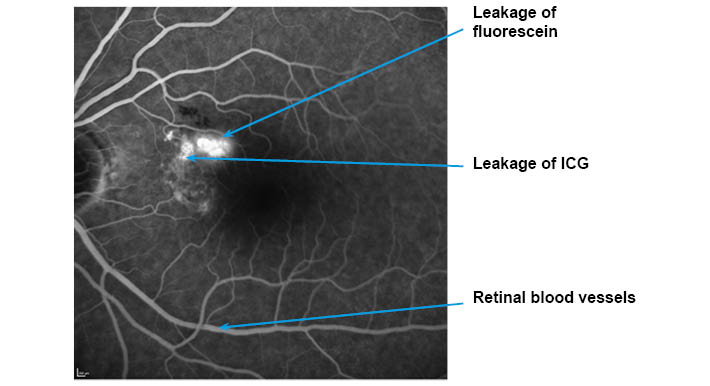Fundus Fluorescein Angiography (FFA) and Indocyanine Green Angiography (ICGA)
Information for patients from Ophthalmology
Now that you have been told that you need fundus fluorescein angiography (FFA), or FFA and indocyanine green angiography (ICGA), you may be wondering what happens next. This leaflet explains what FFA and ICGA are, and why it is carried out. We hope that this will help you reach a decision on whether you wish to have this test.
What is an angiography?
An angiography is a test to check the health of your blood vessels and how blood flows through them.
Fundus fluorescein angiography (FFA) of the eye is the introduction of a fluorescent non-toxic dye into your vein, to highlight both retinal and choroidal circulation.
Who will decide which angiography I will have?
Your doctor will decide if you need only fluorescein or whether you will need both (FFA and ICGA).
Why is this procedure necessary?
This procedure allows your doctor to examine the small blood vessels at the back of your eye, and helps them provide a diagnosis and plan for your treatment.
What is indocyanine green angiography?
Indocyanine green angiography is used to check the blood vessels within your choroid. The choroid is a thin layer of tissue that is part of the middle layer of the wall of your eye.


Are there any alternatives?
Whilst we are able to examine the back of your eye, this is the only effective way of checking the integrity of blood vessels within your eye.
Should I eat and drink before my procedure?
We advise you to eat a light meal before your procedure, and diabetic patients are advised to make sure that they have eaten enough food. There is no need to limit the amount you drink before your procedure.
Should I take my normal medication?
All medication should be continued as ordered by your doctor. However, eyeointments should be avoided until after your procedure, as they are greasy and would affect the images.
Please tell medical and nursing staff of any medication that you use.
What happens before my procedure?
When you arrive in Outpatients a nurse will ask you questions about your general health, and any treatment that you may be taking or have taken in the past. You will be asked to sign a consent form before the test begins. Remember that you can withdraw your consent for treatment at any time.
Please tell the nurse if you have any known allergies (including food allergies), have had a bad reaction to a previous fluorescein angiography test, or you are pregnant, breastfeeding, or if you suffer from kidney failure.
If you are having ICG, please also tell the nurse if you have iodine or seafood allergies.
What happens during the procedure?
Your pupils will be dilated (made bigger) with eye drops.
Your nurse will then pass a small cannula into one of the veins at the back of your hand, through which the fluorescein dye would be given.
A series of photographs are taken as the dye enters the blood vessels at the back of your eye. It is important to keep very still during your procedure.
When can I go home?
Following your procedure, we usually ask you to stay in the department for around half an hour before you can go home.
When will I get the results of my test?
Your results will either be discussed with you straight away, or a follow-up appointment will be made for you to come to the outpatient clinic on another day.
Can I drive home?
You will not be able to drive home or use a mobility scooter after your procedure because of the drops. Please bring someone with you who can drive you home, or make suitable transport arrangements so you can get home afterwards.
You may drive again the day after your procedure, when your vision has returned to normal.
Will the procedure improve my vision?
No, the procedure will not improve or affect your normal vision.
The dilating drops may blur your vision for two to six hours.
What happens following my procedure?
We advise that you do not sit in strong sunshine for 24 hours after your procedure.
If you are having a blood test within the next 24 to 48 hours, please tell your doctor that you have had this test.
If you are diabetic, you may notice some abnormality in the sugar in your urine; this will only last a short while and we recommend that you ignore it.
Your urine will be orange for up to 24 hours, this is only the dye leaving your body.
Please drink plenty of fluids following your procedure.
Are there any side effects or risks to having this procedure?
All procedures, no matter how big or small, carry a risk.
During the procedure you may feel warm or have a ‘hot flush’. This usually happens in the first few minutes and then disappears.
Your skin may be tinged with yellow and your urine may be discoloured for 24 hours after your procedure. This is normal and wears off as the dye leaves your body.
You may feel nauseous (sick), a few people vomit, and some people feel faint, but this does not last.
Around one patient in every 20,000 will have a moderate to severe reaction to the dye, known as anaphylactic shock (collapse and / or severe breathlessness).
You may have sneezing, itching, or pyrexia (high temperature).
The dye is not radioactive, so no radiation is involved.
In case of emergency, please contact William Harvey Hospital on 01233 633331, and ask for the on-call ophthalmologist.